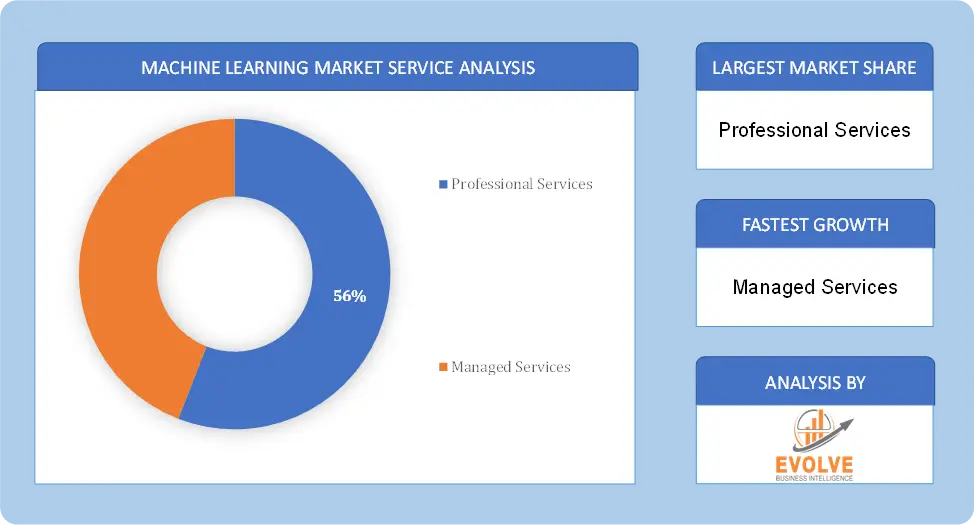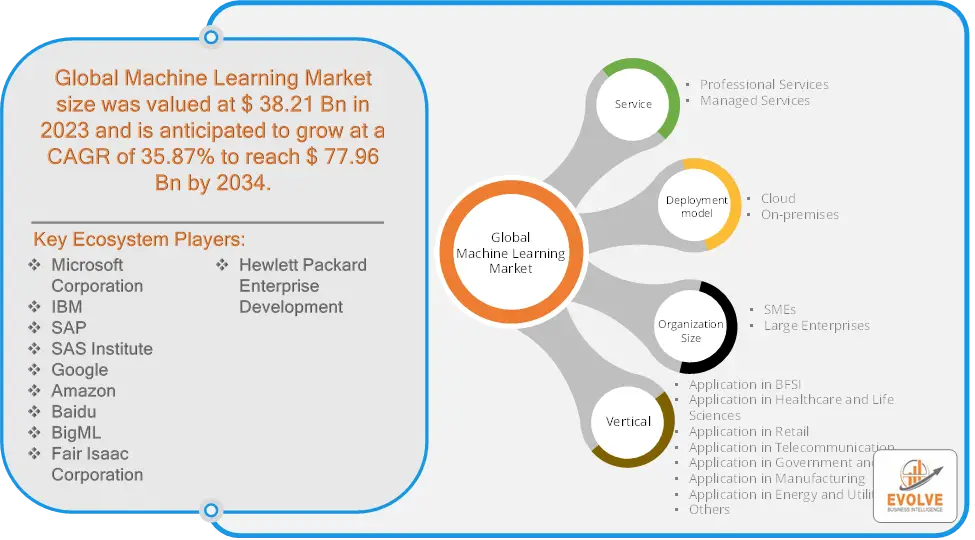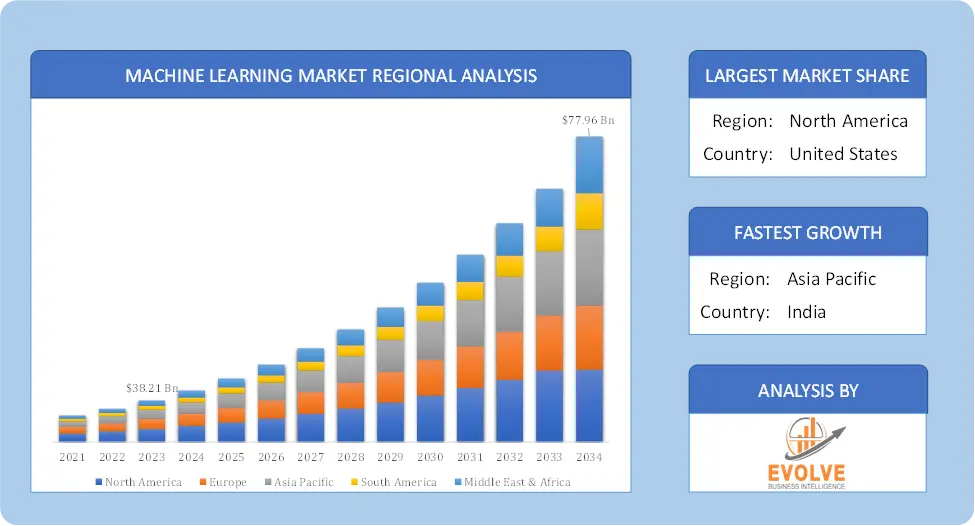Machine Learning Market Analysis and Global Forecast 2024-2034
$ 1,390.00 – $ 5,520.00Price range: $ 1,390.00 through $ 5,520.00
Machine Learning Market Research Report: Information By Service (Professional Services, Managed Services), By Deployment Model (Cloud, On-premises), By Organization Size (SMEs, Large Enterprises), By Vertical (Application in BFSI, Application in Healthcare and Life Sciences, Application in Retail, Application in Telecommunication, Application in Government and Defense, Application in Manufacturing, Application in Energy and Utilities, Others), and by Region — Forecast till 2034
Page: 126
Machine Learning Market Overview
The Machine Learning Market accounted for USD 38.21 Billion in 2023 and is estimated to account for 45.36 billion in 2024. The Market is expected to reach USD 77.96 Billion by 2034 growing at a compound annual growth rate (CAGR) of 35.87% from 2024 to 2034. The Machine Learning Market refers to the industry focused on the development, deployment, and use of machine learning technologies and Deployment Models. Machine learning, a subset of artificial intelligence (AI), involves algorithms and statistical models that enable computers to learn from and make predictions or decisions based on data without being explicitly programmed.
The machine learning market is experiencing significant growth due to the increasing availability of data, advancements in algorithms, and the growing recognition of its potential to drive innovation and improve business outcomes.
Global Machine Learning Market Synopsis
 Machine Learning Market Dynamics
Machine Learning Market Dynamics
The major factors that have impacted the growth of Machine Learning Market are as follows:
Drivers:
Ø Advancements in Computing Power
The availability of high-performance computing resources, including GPUs and cloud computing platforms, enables the processing of large datasets and the training of complex machine learning models. Falling costs of computing resources and storage, along with the availability of open-source machine learning frameworks and tools, make it more affordable for businesses to implement machine learning Deployment Models. Consumers and businesses alike are seeking more personalized experiences and products. Machine learning enables advanced personalization by analyzing user behavior and preferences to deliver tailored Deployment Models.
Restraint:
- Perception of Data Privacy and Security Concerns
The use of large datasets for training machine learning models raises concerns about data privacy and security. Ensuring compliance with data protection regulations like GDPR and HIPAA can be challenging. Although costs for machine learning technologies are decreasing, implementing ML Deployment Models can still be expensive. This includes costs related to hardware, software, and skilled personnel.
Opportunity:
⮚ Growth in Healthcare Innovations
Machine learning offers substantial opportunities in healthcare, including personalized medicine, predictive diagnostics, drug discovery, and medical imaging. The potential to improve patient outcomes and reduce costs drives investment and adoption in this sector. The development of autonomous systems, such as self-driving cars, drones, and robots, relies heavily on machine learning. This sector is poised for growth as technology advances and regulatory frameworks evolve. Machine learning is transforming the financial sector with applications in fraud detection, algorithmic trading, risk management, and customer insights. The increasing complexity of financial transactions drives demand for sophisticated ML Deployment Models.
Machine Learning Market Segment Overview
By Service
 Based on Service, the market is segmented based on Professional Services and Managed Services. The Professional Services segment dominant the market. The Professional Services segment is essential for helping organizations leverage machine learning effectively, ensuring that they can capitalize on the technology’s potential while addressing challenges related to implementation, integration, and ongoing management.
Based on Service, the market is segmented based on Professional Services and Managed Services. The Professional Services segment dominant the market. The Professional Services segment is essential for helping organizations leverage machine learning effectively, ensuring that they can capitalize on the technology’s potential while addressing challenges related to implementation, integration, and ongoing management.
By Deployment Model
Based on Deployment Model, the market segment has been divided into Cloud and On-premises. The cloud-based segment dominant the market. The segment’s growth is attributed to the presence of cloud computing making machine learning easily accessible. The rising deployment of cloud machine learning in numerous organizations is due to the offering of high-end services, and computer storage essential for machine learning training algorithms. Cloud computing in machine learning aims to make operations in a firm or organization cost-effective and flexible.
By Organization Size
Based on Organization Size, the market segment has been divided into SMEs and Large Enterprises. The large enterprises segment dominant the market. The growth of the segment is attributed due to the higher need for data management in large-scale enterprises. Machine learning is the leading term in the race for artificial intelligence. Machine learning is considered another advanced breakthrough in the field of artificial intelligence. Machine learning algorithms are trained to make better and more precise decision-making from historical data. Many of large enterprises use machine learning for making better decisions in the part of inventory, supply chain, customer satisfaction, etc.
By Vertical
Based on Vertical, the market segment has been divided into Application in BFSI, Application in Healthcare and Life Sciences, Application in Retail, Application in Telecommunication, Application in Government and Defense, Application in Manufacturing, Application in Energy and Utilities and Others. The healthcare segment dominated the market. The growth of the segment is attributed to the rising integration of machine learning Deployment Models in the healthcare industry along with multiple other automation Deployment Models. Machine learning used in the healthcare industry aims to help medical professionals with effective patient care and the management of medical data.
Global Machine Learning Market Regional Analysis
Based on region, the global Machine Learning Market has been divided into North America, Europe, Asia-Pacific, the Middle East & Africa, and Latin America. North America is projected to dominate the use of the Machine Learning Market followed by the Asia-Pacific and Europe regions.
 Global Machine Learning North America Market
Global Machine Learning North America Market
North America holds a dominant position in the Machine Learning Market. North America, particularly the United States, is a leading player in the machine learning market. Strong technological infrastructure, a large pool of skilled professionals, and significant investments in research and development contribute to its dominance and it have high investment in research and development, presence of major tech companies, advanced infrastructure, and early adoption of new technologies.
Global Machine Learning Asia-Pacific Market
The Asia-Pacific region has indeed emerged as the fastest-growing market for the Machine Learning Market industry. The Asia-Pacific region is witnessing significant growth in the machine learning market, driven by countries like China and India. Rapid digital transformation, large volumes of data, and significant investments in technology infrastructure and growth in sectors such as retail, healthcare, and financial services. Increasing adoption of ML in emerging economies.
Competitive Landscape
The global Vehicle Leasing Market is highly competitive, with numerous players offering a wide range of software Deployment Models. The competitive landscape is characterized by the presence of established companies, as well as emerging startups and niche players. To increase their market position and attract a wide consumer base, the businesses are employing various strategies, such as product launches, and strategic alliances.
Prominent Players:
- Microsoft Corporation
- IBM
- SAP
- SAS Institute
- Amazon
- Baidu
- BigML
- Fair Isaac Corporation
- Hewlett Packard Enterprise Development.
Recent Development
In July 2023, Deci AI Ltd., a Deep learning automation startup, announced the launch of an open-source and free artificial intelligence tool that can manage datasets for the model training process. Deci is a manufacturer of machine learning development platform which is used to make, optimize and deploy artificial intelligence in the cloud on mobile or at-edge devices.
Scope of the Report
Global Machine Learning Market, Service
- Professional Services
- Managed Services
Global Machine Learning Market, by Deployment model
- Cloud
- On-premises
Global Machine Learning Market, by Organization Size
- SMEs
- Large Enterprises
Global Machine Learning Market, by Vertical
- Application in BFSI
- Application in Healthcare and Life Sciences
- Application in Retail
- Application in Telecommunication
- Application in Government and Defense
- Application in Manufacturing
- Application in Energy and Utilities
- Others
Global Machine Learning Market, by Region
- North America
- US
- Canada
- Mexico
- Europe
- UK
- Germany
- France
- Italy
- Spain
- Benelux
- Nordic
- Rest of Europe
- Asia Pacific
- China
- Japan
- South Korea
- Indonesia
- Austalia
- Malaysia
- India
- Rest of Asia Pacific
- South America
- Brazil
- Argentina
- Rest of South America
- Middle East & Africa
- Saudi Arabia
- UAE
- Egypt
- South Africa
- Rest of Middle East & Africa
| Parameters | Indicators |
|---|---|
| Market Size | 2033: $ 77.96 Billion |
| CAGR | 35.87% CAGR (2023-2033) |
| Base year | 2022 |
| Forecast Period | 2023-2033 |
| Historical Data | 2021 |
| Report Coverage | Revenue Forecast, Competitive Landscape, Growth Factors, and Trends |
| Key Segmentations | Service, Deployment model, Organization Size, Vertical |
| Geographies Covered | North America, Europe, Asia-Pacific, Latin America, Middle East, Africa |
| Key Vendors | Microsoft Corporation, IBM, SAP, SAS Institute, Google, Amazon, Baidu, BigML, Fair Isaac Corporation and Hewlett Packard Enterprise Development |
| Key Market Opportunities | • Growth in Healthcare Innovations • Advancements in Autonomous Systems |
| Key Market Drivers | • Advancements in Computing Power • Cost Reduction of Machine Learning Technologies |
REPORT CONTENT BRIEF:
- High-level analysis of the current and future Machine Learning Market trends and opportunities
- Detailed analysis of current market drivers, restraining factors, and opportunities in the future
- Machine Learning Market historical market size for the year 2021, and forecast from 2024 to 2034.
- Machine Learning Market share analysis at each product level
- Competitor analysis with detailed insight into its product segment, Government & Defense strength, and strategies adopted.
- Identifies key strategies adopted including product launches and developments, mergers and acquisitions, joint ventures, collaborations, and partnerships as well as funding taken and investment done, among others.
- To identify and understand the various factors involved in the global Machine Learning Market affected by the pandemic
- To provide a detailed insight into the major companies operating in the market. The profiling will include the Government & Defense health of the company’s past 2-3 years with segmental and regional revenue breakup, product offering, recent developments, SWOT analysis, and key strategies.
Press Release

Global Pharmaceutical Manufacturing Market to Reach $1.38 Trillion by 2035 with 7.35% CAGR, New Research Shows

The Global Mammography Market Is Estimated To Record a CAGR of Around 10.29% During The Forecast Period

Glue Stick Market to Reach USD 2.35 Billion by 2034

Podiatry Service Market to Reach USD 11.88 Billion by 2034

Microfluidics Technology Market to Reach USD 32.58 Billion by 2034

Ferric Chloride Market to Reach USD 10.65 Billion by 2034

Family Practice EMR Software Market to Reach USD 21.52 Billion by 2034

Electric Hairbrush Market to Reach USD 15.95 Billion by 2034

Daily Bamboo Products Market to Reach USD 143.52 Billion by 2034

Cross-border E-commerce Logistics Market to Reach USD 112.65 Billion by 2034
Frequently Asked Questions (FAQ)
What is the study period of this market?
The study period of the global Machine Learning Market is 2024- 2034
What is the growth rate of the global Machine Learning Market?
The global Machine Learning Market is growing at a CAGR of 35.87% over the next 10 years
Which region has the highest growth rate in the market of Machine Learning Market?
Asia Pacific is expected to register the highest CAGR during 2024-2034
Which region has the largest share of the global Machine Learning Market?
North America holds the largest share in 2022
Who are the key players in the global Machine Learning Market?
Microsoft Corporation, IBM, SAP, SAS Institute, Google, Amazon, Baidu, BigML, Fair Isaac Corporation and Hewlett Packard Enterprise Development. and Raytheon Company are the major companies operating in the market
Do you offer Post Sale Support?
Yes, we offer 16 hours of analyst support to solve the queries
Do you sell particular sections of a report?
Yes, we provide regional as well as country-level reports. Other than this we also provide a sectional report. Please get in contact with our sales representatives
Table of Content
Chapter 1. Executive Summary Chapter 2. Scope Of The Study 2.1. Market Definition 2.2. Scope Of The Study 2.2.1. Objectives of Report Chapter 3. Evolve BI Methodology Chapter 4. Market Insights and Trends 4.1. Supply/ Value Chain Analysis 4.2. Porter’s Five Forces Analysis 4.2.1. Threat Of New Entrants 4.2.2. Bargaining Power Of Buyers 4.2.3. Bargaining Power Of Suppliers 4.2.4. Threat Of Substitutes 4.2.5. Industry Rivalry 4.3. Impact of COVID-19 on Machine Learning Market 4.3.1. Impact on Market Size 4.3.2. Vertical Trend, Preferences and Budget Impact 4.3.3. Regulatory Framework/Government Policies 4.3.4. Key Players Strategy to Tackle Negative Impact 4.3.5. Opportunity Window Chapter 5. Market Dynamics 5.1. Introduction 5.2. DRO Analysis 5.2.1. Drivers 5.2.2. Restraints 5.2.3. Opportunities Chapter 6. Global Machine Learning Market, By Service 6.1. Introduction 6.2. Professional Services 6.3. Managed Services Chapter 7. Global Machine Learning Market, By Deployment Model 7.1. Introduction 7.2. Cloud 7.3. On-premises Chapter 8. Global Machine Learning Market, By Organization Size 8.1. Introduction 8.2. SMEs 8.3. Large Enterprises Chapter 9. Global Machine Learning Market, By Vertical 9.1. Introduction 9.2. Applications in BFSI 9.3. Applications in Healthcare and Life Sciences 9.4. Applications in Retail 9.5. Applications in Telecommunication 9.6. Applications in Government and Defense 9.7. Applications in Manufacturing 9.8. Applications in Energy and Utilities 9.9. Others Chapter 10. Global Machine Learning Market, By Region 10.1. Introduction 10.2. North America 10.2.1. Introduction 10.2.2. Driving Factors, Opportunity Analyzed and Key Trends 10.2.3. Market Size and Forecast, By Country, 2020 - 2028 10.2.4. Market Size and Forecast, By Service, 2020 - 2028 10.2.5. Market Size and Forecast, By Deployment Model, 2020 - 2028 10.2.6. Market Size and Forecast, By Organization Size, 2020 – 2028 10.2.7. Market Size and Forecast, By Vertical, 2020 – 2028 10.2.8. US 10.2.8.1. Introduction 10.2.8.2. Driving Factors, Opportunity Analyzed and Key Trends 10.2.8.3. Market Size and Forecast, By Service, 2020 - 2028 10.2.8.4. Market Size and Forecast, By Deployment Model, 2020 - 2028 10.2.8.5. Market Size and Forecast, By Organization Size, 2020 – 2028 10.2.8.6. Market Size and Forecast, By Vertical, 2020 - 2028 10.2.9. Canada 10.2.9.1. Introduction 10.2.9.2. Driving Factors, Opportunity Analyzed and Key Trends 10.2.9.3. Market Size and Forecast, By Service, 2020 - 2028 10.2.9.4. Market Size and Forecast, By Deployment Model, 2020 - 2028 10.2.9.5. Market Size and Forecast, By Organization Size, 2020 – 2028 10.2.9.6. Market Size and Forecast, By Vertical, 2020 - 2028 10.3. Europe 10.3.1. Introduction 10.3.2. Driving Factors, Opportunity Analyzed and Key Trends 10.3.3. Market Size and Forecast, By Country, 2020 - 2028 10.3.4. Market Size and Forecast, By Service, 2020 - 2028 10.3.5. Market Size and Forecast, By Deployment Model, 2020 - 2028 10.3.6. Market Size and Forecast, By Organization Size, 2020 – 2028 10.3.7. Market Size and Forecast, By Vertical, 2020 – 2028 10.3.8. Germany 10.3.8.1. Introduction 10.3.8.2. Driving Factors, Opportunity Analyzed and Key Trends 10.3.8.3. Market Size and Forecast, By Service, 2020 - 2028 10.3.8.4. Market Size and Forecast, By Deployment Model, 2020 - 2028 10.3.8.5. Market Size and Forecast, By Organization Size, 2020 – 2028 10.3.8.6. Market Size and Forecast, By Vertical, 2020 - 2028 10.3.9. France 10.3.9.1. Introduction 10.3.9.2. Driving Factors, Opportunity Analyzed and Key Trends 10.3.9.3. Market Size and Forecast, By Service, 2020 - 2028 10.3.9.4. Market Size and Forecast, By Deployment Model, 2020 - 2028 10.3.9.5. Market Size and Forecast, By Organization Size, 2020 – 2028 10.3.9.6. Market Size and Forecast, By Vertical, 2020 - 2028 10.3.10. UK 10.3.10.1. Introduction 10.3.10.2. Driving Factors, Opportunity Analyzed and Key Trends 10.3.10.3. Market Size and Forecast, By Service, 2020 - 2028 10.3.10.4. Market Size and Forecast, By Deployment Model, 2020 - 2028 10.3.10.5. Market Size and Forecast, By Organization Size, 2020 – 2028 10.3.10.6. Market Size and Forecast, By Vertical, 2020 - 2028 10.3.11. Italy 10.3.11.1. Introduction 10.3.11.2. Driving Factors, Opportunity Analyzed and Key Trends 10.3.11.3. Market Size and Forecast, By Service, 2020 - 2028 10.3.11.4. Market Size and Forecast, By Deployment Model, 2020 - 2028 10.3.11.5. Market Size and Forecast, By Organization Size, 2020 – 2028 10.3.11.6. Market Size and Forecast, By Vertical, 2020 - 2028 10.3.12. Rest Of Europe 10.3.12.1. Introduction 10.3.12.2. Driving Factors, Opportunity Analyzed and Key Trends 10.3.12.3. Market Size and Forecast, By Service, 2020 - 2028 10.3.12.4. Market Size and Forecast, By Deployment Model, 2020 - 2028 10.3.12.5. Market Size and Forecast, By Organization Size, 2020 – 2028 10.3.12.6. Market Size and Forecast, By Vertical, 2020 - 2028 10.4. Asia-Pacific 10.4.1. Introduction 10.4.2. Driving Factors, Opportunity Analyzed and Key Trends 10.4.3. Market Size and Forecast, By Country, 2020 - 2028 10.4.4. Market Size and Forecast, By Service, 2020 - 2028 10.4.5. Market Size and Forecast, By Deployment Model, 2020 - 2028 10.4.6. Market Size and Forecast, By Organization Size, 2020 – 2028 10.4.7. Market Size and Forecast, By Vertical, 2020 - 2028 10.4.8. China 10.4.8.1. Introduction 10.4.8.2. Driving Factors, Opportunity Analyzed and Key Trends 10.4.8.3. Market Size and Forecast, By Service, 2020 - 2028 10.4.8.4. Market Size and Forecast, By Deployment Model, 2020 - 2028 10.4.8.5. Market Size and Forecast, By Organization Size, 2020 – 2028 10.4.8.6. Market Size and Forecast, By Vertical, 2020 - 2028 10.4.9. India 10.4.9.1. Introduction 10.4.9.2. Driving Factors, Opportunity Analyzed and Key Trends 10.4.9.3. Market Size and Forecast, By Service, 2020 - 2028 10.4.9.4. Market Size and Forecast, By Deployment Model, 2020 - 2028 10.4.9.5. Market Size and Forecast, By Organization Size, 2020 – 2028 10.4.9.6. Market Size and Forecast, By Vertical, 2020 - 2028 10.4.10. Japan 10.4.10.1. Introduction 10.4.10.2. Driving Factors, Opportunity Analyzed and Key Trends 10.4.10.3. Market Size and Forecast, By Service, 2020 - 2028 10.4.10.4. Market Size and Forecast, By Deployment Model, 2020 - 2028 10.4.10.5. Market Size and Forecast, By Organization Size, 2020 – 2028 10.4.10.6. Market Size and Forecast, By Vertical, 2020 - 2028 10.4.11. South Korea 10.4.11.1. Introduction 10.4.11.2. Driving Factors, Opportunity Analyzed and Key Trends 10.4.11.3. Market Size and Forecast, By Service, 2020 - 2028 10.4.11.4. Market Size and Forecast, By Deployment Model, 2020 - 2028 10.4.11.5. Market Size and Forecast, By Organization Size, 2020 – 2028 10.4.11.6. Market Size and Forecast, By Vertical, 2020 - 2028 10.4.12. Rest Of Asia-Pacific 10.4.12.1. Introduction 10.4.12.2. Driving Factors, Opportunity Analyzed and Key Trends 10.4.12.3. Market Size and Forecast, By Service, 2020 - 2028 10.4.12.4. Market Size and Forecast, By Deployment Model, 2020 - 2028 10.4.12.5. Market Size and Forecast, By Organization Size, 2020 – 2028 10.4.12.6. Market Size and Forecast, By Vertical, 2020 - 2028 10.5. Rest Of The World (RoW) 10.5.1. Introduction 10.5.2. Driving Factors, Opportunity Analyzed and Key Trends 10.5.3. Market Size and Forecast, By Service, 2020 - 2028 10.5.4. Market Size and Forecast, By Deployment Model, 2020 - 2028 10.5.5. Market Size and Forecast, By Organization Size, 2020 – 2028 10.5.6. Market Size and Forecast, By Vertical, 2020 - 2028 10.5.7. Market Size and Forecast, By Region, 2020 - 2028 10.5.8. South America 10.5.8.1. Introduction 10.5.8.2. Driving Factors, Opportunity Analyzed and Key Trends 10.5.8.3. Market Size and Forecast, By Service, 2020 - 2028 10.5.8.4. Market Size and Forecast, By Deployment Model, 2020 - 2028 10.5.8.5. Market Size and Forecast, By Organization Size, 2020 – 2028 10.5.8.6. Market Size and Forecast, By Vertical, 2020 - 2028 10.5.9. Middle East & Afirica 10.5.9.1. Introduction 10.5.9.2. Driving Factors, Opportunity Analyzed and Key Trends 10.5.9.3. Market Size and Forecast, By Service, 2020 - 2028 10.5.9.4. Market Size and Forecast, By Deployment Model, 2020 - 2028 10.5.9.5. Market Size and Forecast, By Organization Size, 2020 – 2028 10.5.9.6. Market Size and Forecast, By Vertical, 2020 - 2028 Chapter 11. Competitive Landscape 11.1. Introduction 11.2. Vendor Share Analysis, 2020/Key Players Positioning, 2020 Chapter 12. Company Profiles 12.1. Microsoft Corporation 12.1.1. Business Overview 12.1.2. Financial Analysis 12.1.3. Product Portfolio 12.1.4. Recent Development and Strategies Adopted 12.1.5. SWOT Analysis 12.2. IBM 12.2.1. Business Overview 12.2.2. Financial Analysis 12.2.3. Product Portfolio 12.2.4. Recent Development and Strategies Adopted 12.2.5. SWOT Analysis 12.3. SAP 12.3.1. Business Overview 12.3.2. Financial Analysis 12.3.3. Product Portfolio 12.3.4. Recent Development and Strategies Adopted 12.3.5. SWOT Analysis 12.4. SAS Institute 12.4.1. Business Overview 12.4.2. Financial Analysis 12.4.3. Product Portfolio 12.4.4. Recent Development and Strategies Adopted 12.4.5. SWOT Analysis 12.5. Google 12.5.1. Business Overview 12.5.2. Financial Analysis 12.5.3. Product Portfolio 12.5.4. Recent Development and Strategies Adopted 12.5.5. SWOT Analysis 12.6. Amazon 12.6.1. Business Overview 12.6.2. Financial Analysis 12.6.3. Product Portfolio 12.6.4. Recent Development and Strategies Adopted 12.6.5. SWOT Analysis 12.7. Baidu 12.7.1. Business Overview 12.7.2. Financial Analysis 12.7.3. Product Portfolio 12.7.4. Recent Development and Strategies Adopted 12.7.5. SWOT Analysis 12.8. BigML 12.8.1. Business Overview 12.8.2. Financial Analysis 12.8.3. Product Portfolio 12.8.4. Recent Development and Strategies Adopted 12.8.5. SWOT Analysis 12.9. Fair Isaac Corporation 12.9.1. Business Overview 12.9.2. Financial Analysis 12.9.3. Product Portfolio 12.9.4. Recent Development and Strategies Adopted 12.9.5. SWOT Analysis 12.10. Hewlett Packard Enterprise Development 12.10.1. Business Overview 12.10.2. Financial Analysis 12.10.3. Product Portfolio 12.10.4. Recent Development and Strategies Adopted 12.10.5. SWOT Analysis Chapter 13. Key Takeaways
Connect to Analyst
Research Methodology








